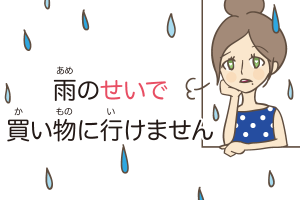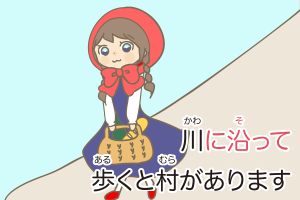Last time, you learned various ways to express reasons, e.g. “地震によって家が壊れました (The house was destroyed due to the earthquake),” and “大雨につき今日はお休みします (We will be closed today due to the heavy rain).” In this lesson, you will learn compound particles which are related to another function of the particle で.
How to Express Space and Time in Various Ways
| Table of Contents Compound Particle Counterparts to the Particle で Other Compound Particles Related to Space and Time |
In the basic grammar section, we explained that the particle で indicates ranges and periods of time, e.g. “野球は日本で人気です (Baseball is popular in Japan)”, and “一時間で宿題をする (I will do my homework for an hour.).” The particle で is certainly powerful and useful. However, if you know compound particles, you can make clearer sentences with various nuances.
Compound Particle Counterparts to the Particle で
The compound particles that we will look at here have specific meanings with a higher level of formality. Although they are interchangeable with the particle で, the detailed nuances are not the same. Let’s learn the usages one by one.
をもって: The Beginning or End of a Period of Time
| [私は] | 3月31日をもって | 退職(する / します) |
| [Topic/Subject] | The End of a Period | Verb |
| [I] will resign on the 31st of March. | ||
をもって can express the beginning or the end of a period of time. をもって sounds formal and is often used in business situations.
| 4月1日をもって新しいカフェをオープンします。 [We] will open a new café on the 1st of April. |
| 10月30日をもってこのお店を閉店します。 [We] will close this shop on the 30th of October. |
Note: For indicating the beginning of a period of time, に will be used, not で. をもって can be replaced like this;
| 4月1日に新しいカフェをオープンします。 |
| 10月30日でこのお店を閉店します。 |
にして: Unexpected Numbers
| 田中さんは | 80歳にして | パソコンを | 始めた / 始めました |
| Topic/Subject | Unexpected Number | Direct Object | Verb |
| Tanaka-san started [using] PC [surprisingly when he was] 80 years old. | |||
にして is used with age or duration and indicates unexpected numbers. You can use にして to show contrast by combining は (*Look at the third example below). Note: にして is not necessarily formal, as it can be used just for emphasis.
| 鈴木さんは18歳にして弁護士に(なった / なりました)。 Suzuki-san became a lawyer [surprisingly when he was] 18 years old. |
| ボブは勉強を始めて3ヶ月にして漢字が(書ける / 書けます)。 Bob started studying and can write Kanji [even if] it’s been only three months [since then]. |
| 10歳にしては体が大きい(です)。 [Considering the fact that he/she is] 10 years old, [his/her] body is big. |
It’s a different function, but にして can replace the te-form of na-adjectives and nouns. This also sounds formal.
医者でお金持ち => 医者にしてお金持ち: doctor and rich
綺麗で頭がいい => 綺麗にして頭がいい: beautiful and smart
[adsense]
において and にて: Locations of Actions
| 送別会は | 東京ホテルにおいて | 行われ(る / ます) |
| [Topic/Subject] | Locations of Action | Verb: Passive Form |
| The farewell party will be held at Tokyo Hotel. | ||
Both において and にて can express locations of actions in a formal way.
| 展示会を東京ミュージアムにおいて開催します。 [We] will open an exhibition in Tokyo Museum. |
| 3階の会議室にてお待ちしています。 [I’m] waiting in the conference room at the third floor. |
において can also be used to express a specific topic for judgment.
| 卓球において、中国は世界で一番強い(です)。 When it comes to table tennis, China is the strongest in the world. |
When they are used with nouns which indicate time, において and にて express different meanings. にて indicates an ending time in the same way as をもって.
| パンの販売は3時にて終了しました。 パンの販売は3時をもって終了しました。 As for the sale of bread, [we] finished [it] at 3:00pm. |
において is a formal way to indicate a time when events take place, which can substitute for both the particles で and に. However, you can only use it with a very limited number of nouns with the following suffixes: “世紀: century,” “時代: era,” “期: term,” “末: end,” “時点: moment,” etc.
| 19世紀 で・において 、石炭は重要なエネルギー(だった / でした)。 In the 19th century, coal was an important [source of] energy. |
| 3月末 に・において 、20歳以上の人が調査の対象(だ / です)。 People who are over 20 years old in the end of March are the targets of the survey. |
| 明治時代 に・において 、日本人は侍であることを(やめた / やめました)。 In the Meiji era, Japanese people stopped being ‘samurai.’ |
If you say における, you can directly connect it with a wider range of nouns in the same way as particle の, but it is much more formal.
| 3月 の・における 売上は過去最高(だった / でした)。 The sales in March were the highest ever. |
| 2012年 の・における 円高はやや異常(だった / でした)。 The appreciation of the yen in 2012 was somewhat abnormal. |
Other Compound Particles Related to Space and Time
In addition to these interchangeable counterparts to the particle で, we would like to introduce some other compound particles related to space and time. These are NOT interchangeable with the particle で.
にわたって: Ongoing Events Over Large Areas / Periods of Time
| 雪が | 一ケ月にわたって | 降った / 降りました |
| [Topic/Subject] | Period of Time | Verb |
| [It] snowed for the whole month. | ||
When にわたって is connected with nouns indicating a long period, it expresses that there are ongoing events over the period. If you connect it with nouns which indicate a large area, you express that events take place over the whole area.
| 一週間にわたって会議が行われ(る / ます)。 The meetings will be held throughout the whole week. |
| 雨が3ヶ月にわたって降って(いない / いません)。 It hasn’t rained for the whole three months. |
| 公園全体にわたって桜が(咲いた / 咲きました)。 Cherry blossoms came out all around the park. |
を通じて: Something (Not Ongoing Events) Over Large Areas / Periods of Time
| 日本は | 一年を通じて | 晴れの日が | 多い(です) |
| Topic | Period of Time | Subject | Predicate |
| In Japan, there are a lot of sunny days throughout the year. | |||
を通じて is connected with nouns which indicate a period and indicates “throughout” in Japanese. This is rarely used with nouns which indicate an area, but if that is the case, you express that something happens throughout the area. を通(とお)して is sometimes used instead of を通じて. They have the same function.
| 四季を通じて、美味しい魚が食べ(られる / られます)。 Delicious fishes can be eaten throughout the four seasons. |
| この一ケ月を通じて、雨の日が(なかった / ありませんでした)。 There weren’t any rainy days all this month. |
Difference between にわたって and を通じて
| 雪が一ケ月 にわたって・を通じて(降った / 降りました)。 |
The basic rule is that にわたって is more suitable if you express ongoing events, i.e. when you say it snowed for the whole month, にわたって is suitable because the snow was ongoing.
| 四季 にわたって・を通じて、美味しい魚が食べ(られる / られます)。 |
When you say delicious fishes can be eaten throughout the four seasons, を通じて is suitable because nothing actually happens, but you just tell the fact.
| 雨が3ヶ月 にわたって・を通じて 降って(いない / いません)。 |
With the example above, they are interchangeable because you can treat it as both “the state of not raining is ongoing” and “no action is happening.”
にかけて: Vague Ending Points
| 桜は | 3月から | 4月にかけて | 咲く / 咲きます |
| Topic / Subject | Starting Point | Ending Point | Verb |
| Cherry blossoms come out from March through to April. | |||
にかけて is connected with nouns which indicate a period or an area and expresses the ending point. This is similar to the particle まで. The difference is that にかけて is more suitable when the beginning and the end are vague. If there is a specific end, まで should be used (*Look at the third example below).
| 日本は11月から2月にかけて寒く(なる / なります)。 In Japan, it gets cold from November to February. |
| この虫は日本から中国にかけて生息して(いる / います)。 This insect exists from Japan across to China. |
| 12時から1時 まで・にかけて 昼休み(だ / です)。 It’s lunch time from 12 o’clock to 1 o’clock. |
にわたって sometimes substitutes for にかけて for large areas, but not for time.
| 日本は11月から2月にわたって寒く(なる / なります)。 |
| この虫は日本から中国にわたって生息して(いる / います)。 |
Summary
- をもって indicates the beginning or the end of a period of time.
- にして indicates unexpected numbers.
- において and にて indicate locations of actions.
- にわたって indicates ongoing events over large areas or periods of time.
- を通じて indicates something (not ongoing events) over large areas or periods of time.
- にかけて indicates vague ending points.
- をもって, にして, において, and にて are interchangeable with で.
- にわたって, を通じて, and にかけて are NOT interchangeable with で.
You may be surprised that there are so many compound particles. We recommend you firstly try to recognize them when native speakers use them. Then, once you have become familiar with these formal expressions, you can start using them yourself. Actually, there are still other compound particles which are the counterparts to the particle で. Next, you will learn ones related to means (e.g. ‘by taxi’) and standards.

How to Express Various Reasons: によって, につき, おかげで, and せいで

Expressions for Means and Standards: によって, を通じて, にて, に沿って, 基づいて, and 即して



